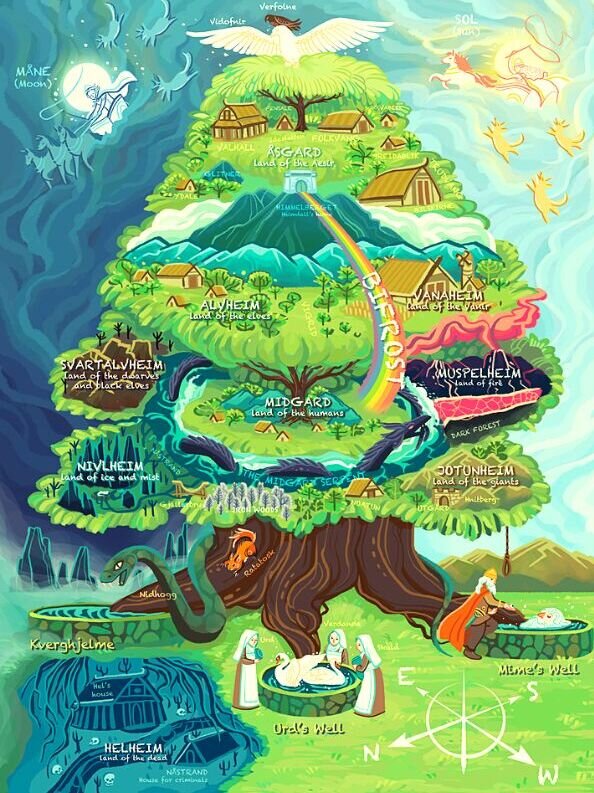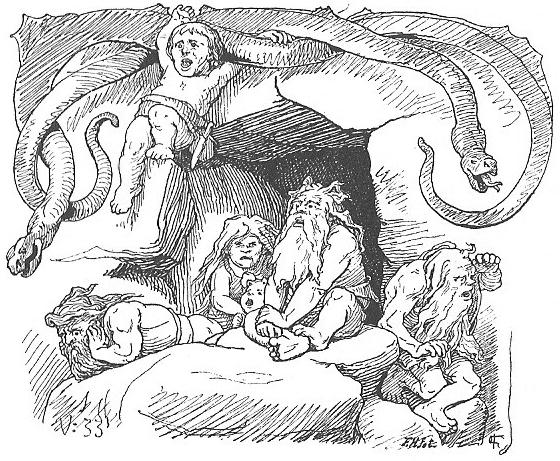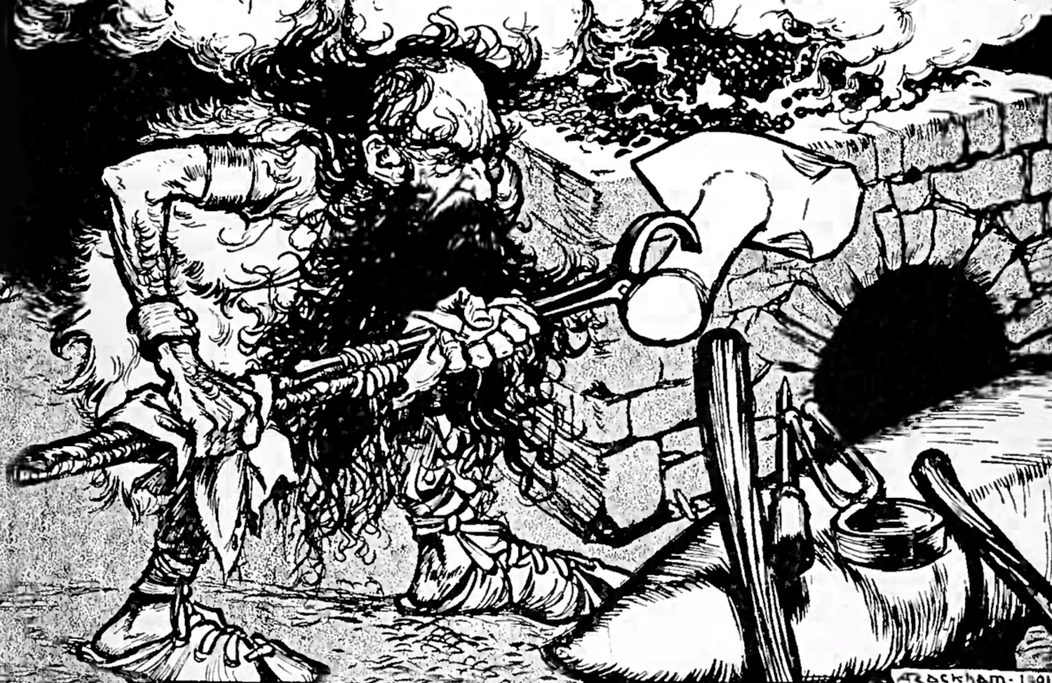Dwarves (also known as “Dvergar” or “Dvergr“) were master blacksmiths, miners, and sages in Old Norse myths and legends. They lived inside mountains in the realm of Nidavellir (or maybe Svartalfheim), were short, sturdy, and had long beards. Exposure to direct sunlight would turn them into stone. Dwarves were not necessarily evil but could be cruel and cunning.
Where do Dwarves Live in the Nine Realms?
There is some confusion about the positions of the various realms within Norse mythology. The placement of Vanaheim, for example, can vary depending on which map you use. However, the most common positions of the nine worlds are as follows:
Asgard always lies in the highest and central section of the world tree or Yggdrasil. Vanaheim and Alfheim usually flank it. Directly below Asgard lies Midgard. The tree trunk usually connects the two places, so the Bifrost or rainbow bridge can join them.
Further down, we have Jotunheim (land of the ice giants) and Muspelheim (land of fire giants and the god Surt).
Niflheim (land of snow and ice) is sometimes separate from Hel (or Helheim – the land of the dead), although some maps show one or the other.
Nidavellir (land of dwarves) also requires a little explanation. Nidavellir is often called Svartalfheim (home of the Black Elves or Svartálfar). However, some maps separate Nidavellir from Svartalfheim and exclude Niflheim or Hel completely.

How Were Norse Dwarves Created?
The sons of Bor Burison, Odin, Vili, and Vé created Midgard using the remains of the frost giant Ymir (or Brimir). Ymir was the oldest being in the whole of Norse myth and lived in the primordial void called Ginnungagap.
The reasons for their decision to kill him are not clear. Some claim they merely wanted a giant being to provide enough material to create a world. Others believe that Ymir’s antics, such as giving birth from his armpits and apparently producing a six-headed being from between his legs, annoyed the gods enough to want him killed.
These three brothers slaying him is ironic, to say the least, as their grandfather, Búri owed his existence to a cow that Ymir suckled on. The cow called Auðumbla liked to lick salty rime stone encased in ice, and this gradually melted, uncovering Búri, who came to life!
Odin killed the giant with his spear. So much blood poured from the wound it drowned all the jötnar except for Bergelmir and his wife. They escaped in a hollowed-out log and were responsible for the subsequent repopulation of the giants in Jotunheim.
Some of Ymir’s flesh, blood, and bones created the race of dwarves. In several accounts, the Æsir (or pantheon of Norse gods) created dwarves out of the worms and maggots feeding on the giant’s corpse (see the attestations in the Gylfaginning from the Prose Edda further on in the article).
Dwarves and the Birth of Midgard
The brothers took the giant’s body (Yimir’s) to the center of the universe and used his body parts to create Midgard. They used his flesh to develop the land; his blood became the oceans. His bones made the mountains, his teeth the cliffs, and his hair the trees! His brains scattered across the sky to form clouds.
The trio commanded four dwarves to hold Ymir’s skull above the new world to create the sky. The dwarves’ names provided the four compass points: Nordri, Sudri, Austri, and Vestri. Scattered sparks caught in the skull gave the sun, moon, and stars.
To protect the new world they had made, they used Ymir’s eyebrows to fence off Midgard from the rest of the universe, only allowing access to Asgard via the Bifrost.
Are Norse Dark Elves Dwarves?
In the Prose Edda, Sturluson’s uses of “dvergar” (dwarves), svartálfar (black elves), “ljósálfar” (light elves), and dökkálfar (dark elves) are confusing, so it is difficult to say if they are interchangeable.
Svartalfheim, the land of the dwarves, means “realm of the Black Elves.”

Dwarves in Norse Mythology stories
The Mead of Poetry
The three horns of Odin may also share a connection with the two vats and a cauldron the dwarves Fjalar and Galar used to store the legendary mead of poetry. In common with so many Norse legends, inanimate objects had names, and these storage vessels were no different. The vats were called Boðn and Són, and the cauldron Óðrœrir.
Fjalar and Galar had killed the spreader of wisdom, Kvasir (born of the saliva of the Æsir and Vanir), added honey to his blood and created the mead of poetry. Drinking this mead gave wisdom and the gift of skaldship: the ability to compose the complex and sophisticated skaldic poetry.
Suttungr came into possession of the vessels after the dwarves had offered them in return for their lives. The giant had trapped them on a reef during a low tide, and they faced death by drowning.
Freyr
The god Freyr, ruler of the elf kingdom, Alfheim, rode the golden-bristled boar Gullinbursti, created by dwarves.
The dwarf mastercraftsmen known as the Sons of Ivaldi also created his magic ship Skidbladnir, described as the finest ever made. It always found fair winds and could fold up and fit inside a bag!
Idun
The Norse goddess Idun was the wife of Bragi, the god of poetry. She was the guardian of the magical apples that maintained the youth and vigor of the Æsir, the gods of the most important pantheon in Viking and Old Norse religion. Her father was the dwarf Ivaldi, so she was also a sister of the Sons of Ivaldi.
Attestations in the Poetic Edda
Hyndluljóð
The dwarfs Dáinn and Nabbi appear in the Hyndluljóð, telling the story of how they created the goddess Freyja’s boar Hildisvíni.
A dwarf called Dain, son of Nain, also appears in Tolkien’s The Hobbit, the prequel to The Lord of the Rings.
Alvíssmál
Alvíss was engaged to be married to Þrúðr, Thor’s daughter. Thor disapproved of his daughter marrying so short a suitor and told Alvíss that he had to pass some tests to prove his wisdom.
Thor ensured that the tasks lasted until dawn broke, and Alvíss turned to stone as the first rays of sunlight hit him.
Völuspá
Dvalin is included in a list of dwarfs and then as a dwarf leader involved in a journey to find new lands when his tribe of dwarfs leaves their mountain home.

Attestations in the Prose Edda
The Legend of Brunhilde
The Islandic politician, historian, and poet Snorri Sturluson compiled the Prose Edda in the 13th century, and his version of the most famous Brunhilde story is similar, although shorter, to the one found in the Poetic Edda:
Siegfried (or Sigurd) is returning from a tremendous adventure in which he killed Fáfnir, a dwarf that transformed into a dragon, and Fáfnir’s brother, Regin. Regin was a master smith who had made Siegfried a magical sword called Gram.
He had convinced Siegfried to kill Fáfnir so he could reclaim a share of a trove of golden treasure, including a magic ring called Andvaranaut that Loki had stolen from another dwarf named Andvari. Andvari lived under a waterfall and could change into a pike at will. Loki had undertaken this theft to pay back a debt he owed to King Hreidmar, the father of Fáfnir and Regin. Loki had killed Ótr, Hreidmar’s son, and had to give up Andvaranaut to escape punishment.
Fáfnir decided he wanted the gold instead and killed his father, stealing the hoard and the all-powerful Aegir’s helmet. Using the helmet, he banished Regin, who was badgering him for a share of the gold. After dismissing him, Fáfnir transformed into a dragon and took the gold to a heath called Gnita, where he lay guarding the treasure.
Slaying the Dragon
Siegfried, goaded on by Regin, went to kill Fáfnir, hiding in a ditch on the heath, waiting for the dragon to walk across it on his way to drink. He could then use Gram to thrust upwards and attack the belly of the serpent. His plan worked; he was able to slay the dragon and collect the gold for Regin.
The treacherous Regin now plotted to kill Siegfried too. He pretended to be upset over how Siegfried had murdered his brother and had him roast Fáfnir’s heart to appease him. Feeling pangs of guilt after the killing, Siegfried agreed to cook the heart for Regin to eat.
After a while, he put his thumb into the heart to ensure it was ready. As he licked the blood off it, he found he was suddenly able to understand the language of birds. He heard a pair of eagles nearby discussing how Regin planned to betray and kill Siegfried, so he used Gram to kill him in his sleep.
Gylfaginning
Chapter 14 explains the dwarf origin story:
The dwarfs had taken shape first and acquired life in the flesh of Ymir and were then maggots, but by decision of the gods, they became conscious with intelligence and had the shape of men though they live in the earth and rocks. Modsognir was a dwarf, and the second was Durin.
Mótsognir – Wikipedia
There is also a mention of dwarves in chapter 34 when Odin tells Freyr’s servant Skírnir to go to Svartalfheim to fashion a restraint powerful enough to hold the giant wolf Fenrir.
The dwarves make a manacle and chain called “Gleipnir” out of six magic elements:
- A women’s beard
- The sound of a cat’s tread
- The roots of a mountain
- A bear’s sinews
- Bird spit
- A fish’s breath
Hár (an alias for Odin) describes the manacle as soft as a silk ribbon but strong enough to control the monstrous wolf.
Skáldskaparmál
Perhaps the best-known dwarf was Eitri, the brother of Brokkr. According to Skáldskaparmál, Loki came into possession of Odin’s spear Gungnir (also made by the Sons of Ivaldi), Freyr’s ship Skidbladnir, and a lock of Sif’s hair. He wagered his own head with Brokkr that Eitri could not match the craftsmanship of these items.
Eitri stoked the fire while his brother worked the bellows, but Loki turned into a fly and began biting Brokkr, trying to stop him from keeping the furnace hot.
Eitri won the bet by creating the golden boar Gullinbursti, the gold ring Draupnir, and Thor’s hammer, Mjolnir.
Sörla þáttr
A possible origin story of Brisingamen, Freyja’s necklace, appears in the Sörla þáttr, a short story by priests Jon Thordson and Magnus Thorhalson from the late 14th century.
Freyja desired a golden necklace forged by four dwarves – Dvalin, Alfrik, Berlingr, and Grer. She tried to buy it with gold and silver, but they would only part with it if she spent one night with each of them. Freyja held her part of the bargain and obtained the necklace.

